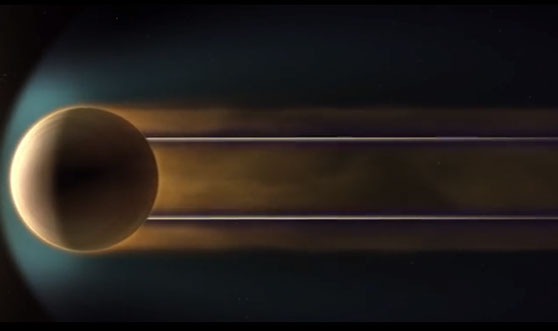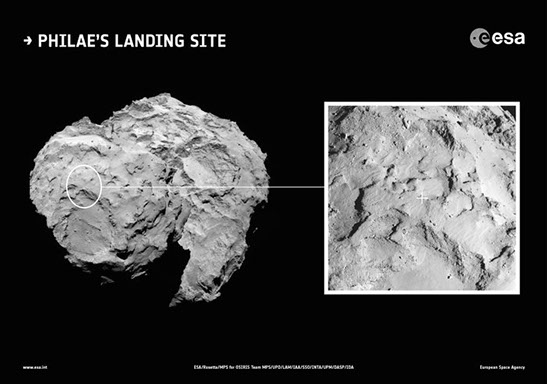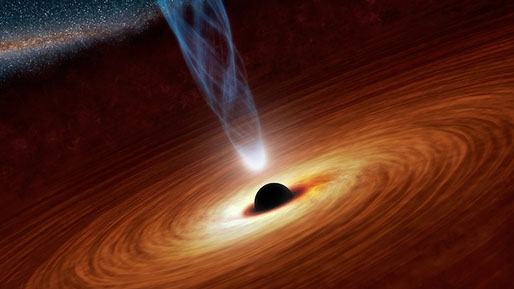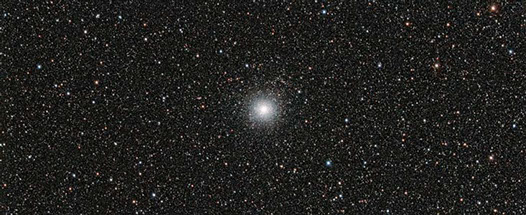

September 2014
Venus
The European Space Agency's Venus Express is shedding new light on the mysterious holes in the Venusian atmosphere. Back in 1978, the NASA Pioneer Venus Orbiter detected a hole in the planet's ionosphere. It discovered that in this area, the density dropped out. Scientists were baffled. Today, Venus Express has been in polar orbit around Venus for the past eight years and has spotted these same holes.

Venus Express has discovered that the ionosphere of Venus is in a shape resembling a comet's tail during times of low solar wind pressure. The solar wind blows the ionosphere around the planet and most of the time the plasma particles from the solar wind form channels on the nightside of the planet. But during low solar pressure, the ionosphere ballooned on the nightside. The cause of this is Venus' weak magnetic field. On Earth there is a strong magnetic field which keeps the ionosphere in a stable shape. But Venus does not have this magnetic field and thus the flow of plasma particles increase as the channels widen due to the lower pressure, which in turn causes the balloon effect.
Pioneer Venus Orbiter only saw the holes in the ionosphere during solar max. But Venus Express has confirmed the holes exist also at solar min. The holes also extend much further in the atmosphere than previously thought.
In July, Venus Express made a daring plunge into the Venusian atmosphere and then climbed back to orbit. As it flew through the holes it recorded a jump in the field strength along with very cold particles flowing in and out of the holes. It detected two holes in the shape of cylinders extending out from the planet's nightside into space. The holes contain low density materials with the highly charged plasma particles having been squeezed out of them. Some sort of magnetic effect must be the cause.
As the magnetic field lines from the sun hit Venus, they wrap around the planet creating two long straight magnetic field lines on the other side of the planet. These lines could squeeze the plasma out and form the holes. But that would place the holes starting on each side of the planet, not directly behind it as the spacecraft have observed.
One theory is that the magnetic field lines hit the planet and instead of bending around, go through the ionosphere and through the outer mantle of the planet itself. They would then hit the planet core that would make them emerge on the other side coming out from the planet. This would require that Venus' interior is made up much like Earth's.
Another theory is that the magnetic fields bend around the planet and collide with other plasma already there on the other side and this interaction forms the holes.
Venus Express is now in a new orbit after the aerobraking maneuver in the Venusian atmosphere. After eight years its propellant is running low and scientists tried and succeeded with an experiment to send the spacecraft surfing through the atmosphere and then plunging it up into a new orbit. This maneuver extended the mission for at least another six months and also provided scientists with a new detailed look at the Venusian atmosphere. Venus Express does not have enough fuel to perform the maneuver again and will eventually completely run out of fuel and drop into the atmosphere for good, ending its mission sometime around December.
Image Credit: NASA's Goddard Space Flight Center/G. Duberstein
Rosetta
Landing site "J" has been selected for Rosetta's Philae lander on comet 67P/Churyumov-Gerasimenko. Rosetta, operated by the European Space Agency (ESA), is the first spacecraft to rendezvous with a comet. The lander Philae is scheduled to touch down on the comet on 11 November.
The site is located on the 'head' of the comet. The backup site is Site C and is located on the 'body' of the comet.
No site was 100% level. Site J contains areas where slopes are less than 30 degrees. It also appears to have few boulders. The site also receives sufficient daily illumination so that Philae will be able to recharge its batteries. Philae is equipped with spikes on its feet to hold it on an inclined and icy surface.
Timing is of the essence also. A landing is desired before mid-November because the comet will be moving closer to the sun and become more active. This could effect the exact landing site as a sudden increase of activity on landing day could affect the position of Rosetta.
Once deployed from Rosetta, all operation will be automatic, already programmed into the lander. Ice screws and harpoons will hold Philae on the surface. During decent, measurements will be taken of the environment. Upon landing a 360 degree panoramic photo will taken of the landing site. At that point the science will begin. Instruments will analyze the plasma and magnetic environment, along with surface and subsurface temperatures. The lander will drill into the surface and analyze the surface content using its on-board laboratory. Philae will also send radio waves through the comet that will be picked up by the orbiting Rosetta.
Comets are the oldest know objects in the solar system. They were formed by material left over when the sun and planets were formed. By analyzing comets we can unlock the evolution of our solar system and perhaps answer questions of how life itself formed.

Credit:ESA/Rosetta/MPS for OSIRIS Team MPS/UPD/LAM/IAA/SSO/INTA/UPM/DASP/IDA
Visit our sponsors.


For advertising opportunities on this page and our videos, contact
Upcoming Launches
Date: September 20
Launch Vehicle: Space-X
Launch Site: Cape Canaveral AFS, Florida
Description: Deliver cargo and crew supplies to the ISS.
Date: September 25
Launch Vehicle: Soyuz
Launch Site: Baikonur Cosmodrome, Kazakhstan
Description: Soyuz 40 will take Barry Wilmore, Elena Serova and Alexander Samokutyaev to the ISS
Galaxy Formation
Data from NASA's Hubble Space Telescope, Spitzer Space Telescope, the Keck Observatory on Mauna Kea, Hawaii and the European Space Agency's Herschel Space Observatory is giving astronomers a first time glimpse at the earliest stages of galaxy formation.
"Sparky" is a dense galactic core that is ablaze with the light of millions of newborn stars forming at a ferocious rate. At a distance of 11 billion light years away, we are seeing the galaxy as it formed only 3 billion years after the Big Bang.
The galactic core contains about twice as many stars as the Milky Way but is only 6,000 light years across (compared to the Milky Way at 100,000 light years across). A core this densely packed has never been seen before and it is believed that t is unique to the early universe. Today the universe is a lot less dense and it cannot create galaxies like that.
Sparky produces about 300 stars per year. The Milky Way produces about 10 stars per year. Astronomers believe that a torrent of gas flowed into the galaxy core while it formed in a well of dark matter. This sparked the birth of stars at this incredible rate.
We see Sparky as it was 11 billion years ago. About a billion years ago Sparky probably slowed down and expanded into an elliptical galaxy like other galaxies in the universe. Because it is so far away, Sparky is affording us a glimpse into the beginnings of the universe.
Asteroid Collision
NASA's Spitzer Space Telescope has witnessed a collision between two large asteroids. Watching the star NGC 2547-ID8 in the constellation Vela, the telescope picked up a huge eruption of dust around the young star. Spitzer has be observing the star because it is a young star and planet formation may be occurring there.
The dust and remains from the collision may combine and grow over time to form rocky planets like the Earth. It is believed the moon may have been formed by a collision between the early-forming Earth and a Mars sized asteroid. A collision of this sort may have been what we see at NGC 2547-ID8. A ring of dust and debris now orbits the star at just the right distance where rocky planets form. Spitzer will continue to monitor the star.
X-Rays Blurred by Black Hole
Most of the light that falls into a black hole never escapes. But high-energy light does shine from the black hole's corona and the surrounding accretion disk. The corona is a compact source of X-rays that sits near the black hole. NASA's Nuclear Spectroscopic Telescope Array (NuSTAR) witnessed an extreme and rare event where the corona collapsed in toward the black hole in a period of just days.
The black hole pulled all the light down onto its surrounding disk. As the corona moved closer to the black hole, the black hole's extreme gravity blurred and stretched the X-rays. As the corona moved toward the inner portion of its superheated disk, it lit up the area in light allowing astronomers to better see the area near the event horizon. The event horizon is the point of no return for anything being sucked into the black hole. NuSTAR looked at the X-rays in the range of 3 to 79 kiloelectron volts.
Around the area of the event horizon the black hole spins at rates nearing the speed of light. It spins so fast that space and time are dragged and distorted. Being able to see this area is a fantastic opportunity for scientists to not only view the previously unseen areas close to black hole, but also view the effects of Einstein's theory of relativity.
It is not known if the corona will remain at the disk or if it will move back. Scientists don't yet know what makes the corona tick, how it is produced or why it changes shape.

Artist Concept. The corona is the bright white area at the bottom of the blue jet.
Credit: NASA/JPL-CalTech
Where Did the Lithium Go?
Lithium is one of the elements produced during the Big Bang along with Hydrogen and Helium, except in much smaller quantities. Scientists should be able to determine very accurately how much Lithium is in the universe. But when they measure it they find there is three times less Lithium in stars than there should be.
Perhaps when the Milky Way formed Lithium somehow got destroyed? Or perhaps during the course of a star's life Lithium is destroyed? No one knows. But now scientists know it is not specific to the Milky Way.
Using the Very Large Telescope (VLT) at ESO's Paranal Observatory in Chile, astronomers have measured the Lithium in the globular cluster M54. M54 is a cluster of hundreds of thousands of old stars. But unlike other globular clusters seen in the night sky, M54 is not part of the Milky Way. Instead, M54 is part of the Sagittarius Dwarf Galaxy, located 90,000 light years away.
The amount of Lithium found in stars in M54 is consistent with levels found in stars in the Milky Way. This means that the low Lithium levels also occur outside our galaxy.
This is a significant step in helping to solve the mystery of 'where did the Lithium go?'.

M54
Credit: ESO
© 2014-2016 Ted Cook Productions LLC. - All Rights Reserved